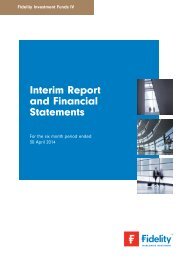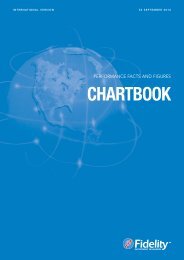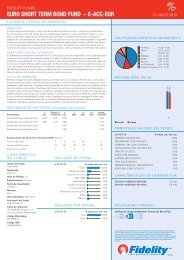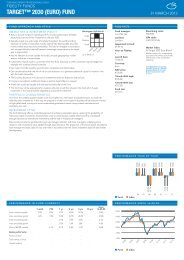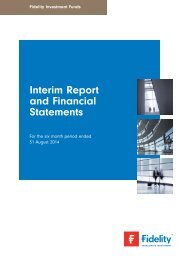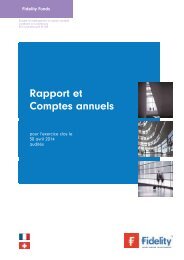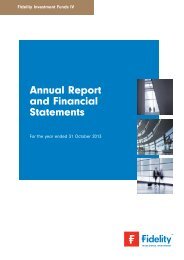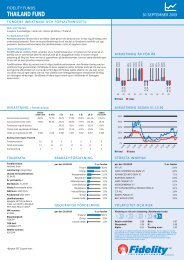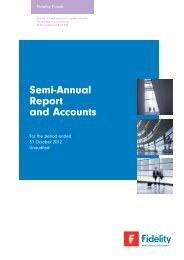MARKET UPDATEOVERVIEW OF THE FOURTH QUARTER OF 2010REVIEW AND OUTLOOK FOR THE MAJOR MARKETSGlobal equities advanced over the October–December quarter,supported by further quantitative easing by major central banks andoptimism that the global economy is picking up steam. In November,markets were subdued amid weak global cues due to sovereign debtconcerns in peripheral eurozone economies, monetary policy tighteningin China and geopolitical tensions in Korea. However, some of thesefears abated in December owing to positive macroeconomic data.Materials and energy stocks outperformed other sectors as oil and<strong>com</strong>modity prices continued to rise, further enhancing investorsentiment. Meanwhile, defensive sectors, notably utilities, lagged. Atthe regional level, Japanese stocks gained the most, followed byequities in the US, Pacific ex Japan, emerging markets and the UK.Europe ex UK equities lagged other regions.depressed housing market, but a rising wealth effect has ensured thathigh-end consumers face a more positive outlook.EUROPEEuropean equities rose in the fourth quarter of 2010, despite worriesabout the debt crisis in Ireland and its spread to other peripheraleconomies, including Portugal and Spain. In order to try to quell thecontagion, the European Union handed Ireland an ?85 billion aidpackage. Additionally, the ECB delayed the withdrawal of its emergencyliquidity measures and bought government bonds in Portugal, Irelandand Greece. Equities were also supported by encouraging earningsresults and economic data. At the sector level, materials names trackedrising <strong>com</strong>modities prices and other cyclical segments, such asindustrials and consumer discretionary, also performed well. Conversely,investors sold shares in financials, though the sector recovered partiallytowards the end of the quarter.Economic data releases over the quarter improved, indicating thepossibility of a more rapid global economic expansion. In the US andthe UK, the manufacturing and retail sectors showed an upbeat trend.Germany’s Ifo index reached a record high (since Germany’s unification)in December. The JPMorgan Global Manufacturing PurchasingManagers’ Index, a measure of the overall health of world economy,rose for the third consecutive month in December. The US FederalReserve’s (Fed) second round of quantitative easing in November,Japan’s ¥5 trillion stimulus package and the European Central Bank’s(ECB) decision to continue its emergency liquidity measures were allsupportive of growth. However, the possible spill over from theEuropean sovereign debt crisis and likely inflationary pressures couldderail the recovery. Already, China has started tightening its policies inresponse to rising prices.Over the quarter, the US dollar weakened against major currencies.UNITED STATESUS equities witnessed another quarter of broad-based gains. A newround of quantitative easing by the Fed, the extension of Bush-era taxbreaks and unemployment benefits offered by the Obamaadministration, <strong>com</strong>bined with business-friendly Republican gains in themid-term elections buoyed investor sentiment and helped offsetconcerns about the fiscal health of peripheral Europe. Investors focusedon improving economic data, which reduced the likelihood of aneconomic “double dip,” and continued strength in corporate earnings.Merger & acquisition activity by cash-rich businesses also fuelled gains.At a sector level, cyclicals outperformed defensives, with energy andmaterial stocks leading because of higher resource prices. Meanwhile,consecutive improvements in retail sales boosted consumerdiscretionary shares.The fifth consecutive monthly increase in personal consumptionexpenditures in November bodes well for the recovery process.Consumer spending accounts for a significant portion of the country’stotal economic output, but has been subdued until recently. Householdsfacing declining net worth, high unemployment and constrainedin<strong>com</strong>es were forced to deleverage and increase their savings behaviourduring the credit crisis. However, recent economic growth and stockmarket gains have provided consumers with the means to beginspending once again. The newly announced fiscal stimulus packageshould support this uptrend. Interestingly, low-end consumers continueto face a challenging environment, given the prevailing joblessness andEurozone’s economic growth slowed in the third quarter; GDPexpanded at 0.4% against 1.0% in the previous three months. Theperipheral economies lagged Germany, as budget cuts aimed atreducing record deficits undermined their recovery. However, the ECBraised its GDP growth forecasts for 2010. In the eurozone, industrialactivity improved and key sentiment indicators moved up over thefourth quarter, although the unemployment rate remained high. Inresponse to the sovereign debt crisis, the ECB kept interest rates onhold, while the annual inflation rate in the region rose to 2.2% inDecember, higher than the ECB’s medium-term target for the first timein two years.UNITED KINGDOMUK equities recorded positive returns in the fourth quarter. Concernsabout the economic recovery eased over the period as the Fedannounced a second round of quantitative easing, while the ECBindicated that it is prepared to extend stimulus measures. Investors alsowel<strong>com</strong>ed plans for the large-scale reduction in UK governmentspending, announced in October, which aims to cut the country’sspiralling public deficit. Improving trends in corporate earnings and bidspeculation further supported stock prices. However, there were majorconcerns around the re-emergence of the European sovereign debtproblem, as Ireland became the second eurozone country to require abailout after Greece. Tensions between North and South Korea, andworries that China’s effort to contain inflation could curb consumption,also dampened investor sentiment to an extent.There was mixed news on the economic front. According to preliminarydata from the Office for National Statistics (ONS), the GDP showed asurprisingly strong increase of 0.8% in the third quarter, suggesting thatthe UK economy is more resilient than many had feared. However, thefigure was later revised marginally downwards to 0.7%, owing to weakergrowth in the construction, business services and manufacturing sectors.Meanwhile, a separate ONS report revealed that the annual rate ofinflation climbed to a six-month high of 3.3% in November from 3.2% inOctober, mainly due to an increase in prices of food, clothing andfurniture. The latest surveys by the Confederation of British Industryshowed upbeat trends in the manufacturing and retail sectors, but theoutlook for the housing market is still uncertain and high unemploymentlevels remain a cause for concern. The Bank of England’s policymakerskept interest rates on hold at 0.5% over the quarter.2
AS AT 31.12.10JAPANThe second round of quantitative easing in the US proved to be a keyturning point for the Japanese market, which had been a notable laggardover the preceding six months. Amid expectations of a brighter outlook forthe US economy, a widening of the interest rate differential with Japan ledto a reversal in the yen and a subsequent rebound in share prices from ayear-to-date low. Thereafter, <strong>com</strong>paratively firm economic data overseas,robust interim earnings and domestic policy support measures (theJapanese government announced a 5% cut in the corporate tax rate fromfiscal 2011 and extended a tax break on securities investment by two years)contributed to the upswing in share prices. Meanwhile, overseas investors,encouraged by the reversal in the yen, stepped up their net purchases ofJapanese stocks. At a sector level, energy financials and informationtechnology registered the strongest returns in the fourth quarter, whereasdefensive segments, notably utilities, struggled.Following relatively robust growth in the third quarter, Japan’s economystarted to slow as the global growth momentum waned, governmentincentives expired and a strong yen took its toll on the <strong>com</strong>petitiveness ofthe country’s exports. While consensus forecasts indicated that real GDPexpanded by around 4.3% in calendar 2010, a rate that <strong>com</strong>paresfavourably with other developed countries, they also suggested that theJapanese economy entered a mild contraction in the fourth quarter.Despite a near-term lull, however, recent economic indicators, includingmanufacturing activity in China and the US, pointed towards signs of atentative rebound in global trade. In November, Japanese export volumesaccelerated for the first time since February and industrial production alsorecovered. Moreover, major sectors, including machinery, electronic partsand autos, indicated further increases in output over the <strong>com</strong>ing months,suggesting that an end to production adjustments may be in sight.PACIFIC EX-JAPANDespite charting an uneven course, equities in the Pacific ex Japan regionended the quarter with significant gains. The quantitative easing in the USand a lower-than-expected decline in Chinese economic growth enthusedinvestors. Most sectors advanced, with information technology and healthcare names among significant performers. Retailers in the shopping hubs ofHong Kong and Singapore also benefited from increased spending bytourists. The resources sector advanced strongly due to optimism about theglobal economy. Rising oil and <strong>com</strong>modity prices further buoyed materialsand energy stocks. Meanwhile, monetary and property tightening measuresin China led to a subdued <strong>performance</strong> on its bourses. Investors also kept aclose watch on the escalating sovereign debt crisis in the eurozone.FIXED INCOMEGlobal bond markets lost ground over the quarter due to renewedworries of contagion risks in the eurozone. Although an ?85 billionbailout package for Ireland was agreed upon in November, the cost ofinsuring against sovereign defaults climbed significantly over thequarter. German government bunds were sold off amid rising concernsthat the country may have to take on more of the burden to rescueperipheral eurozone countries in 2011. In the US, Treasury yieldsincreased in light of expectations that the Fed’s second round ofquantitative easing and an extension of tax cuts may succeed in revivingthe economy. UK Gilts, despite having posted negative returns over thequarter, outperformed US Treasuries and German bunds. Thegovernment’s efforts to cut spending and the euro region’s sovereigndebt crisis fuelled demand for UK Gilts. Within credit, corporatefundamentals remained strong, earnings growth was robust andcorporate default rates continued to decline. However, Europeanfinancials performed poorly, given their overall elevated exposure tosovereign debt. Global inflation-linked bonds recorded negative returnsas inflationary pressures remained subdued in most developedeconomies. In the UK, however, these bonds performed strongly.CONCLUSIONThe near-term outlook for equities is less negative as there are signs ofan uptick in the global recovery, although some downside risks remainas the tailwind from inventory restocking abates. According to data<strong>com</strong>piled by I/B/E/S, analysts’ expectations for global earnings growthin 2011 have gone down moderately, from 15.8% in September 2010 to14.9% in December 2010. At a regional level, emerging economies aregrowing strongly and <strong>com</strong>panies are reporting healthy earnings. Asianequities face the challenge of maintaining the price momentum in lightof monetary tightening in China. The US market could benefit from theproactive stance of the Fed. In contrast, lead indicators in Japan areweak, but corporate profitability is improving despite a stronger yen.Fiscal tightening and falling property prices are undermining theoutlook for Europe.Economic growth in some countries in the region moderated to a moresustainable, albeit solid, pace in the third quarter. China’s industrialproduction, retail sales and fixed asset investment remained robust andsurpassed consensus expectations in October and November. Growth inindustrial activity benefited Singapore, while regional growth and lowinterest rates were supportive of the expansion in Hong Kong. The ReserveBank of Australia and the People’s Bank of China raised benchmark rates totackle the risk of a rise in inflation. Employment numbers improved in HongKong, Singapore and Australia. However, Australian consumers retained acautious outlook on spending and borrowing, which has led to a noticeableincrease in the saving rate. Asset values in Australia have not changedmuch over recent months and overall credit growth remains quite subdued.3
- Page 1 and 2: INTERNATIONAL VERSION 31 JANUARY 20
- Page 3: CONTENTSThis chartbook is intended
- Page 7 and 8: Except for the above list, benchmar
- Page 9 and 10: FIXED INCOME FUND CHARACTERISTICSS&
- Page 11 and 12: FUND NAMEFUND APPROACH AND STYLEA s
- Page 13 and 14: cb.eu.201101.perfsum.den.pdfDENOMIN
- Page 15 and 16: cb.eu.201101.perfsum.den.pdfDENOMIN
- Page 17 and 18: cb.eu.201101.perfsum.usd.pdfUS DOLL
- Page 19 and 20: cb.eu.201101.perfsum.usd.pdfUS DOLL
- Page 21 and 22: cb.eu.201101.perfsum.gbp.pdfSTERLIN
- Page 23 and 24: cb.eu.201101.perfsum.gbp.pdfSTERLIN
- Page 25 and 26: cb.eu.201101.perfsum.dem.pdfEURO (E
- Page 27 and 28: cb.eu.201101.perfsum.dem.pdfEURO (E
- Page 29 and 30: cb.eu.201101.perfsum.chf.pdfSWISS F
- Page 31 and 32: cb.eu.201101.perfsum.chf.pdfSWISS F
- Page 33 and 34: cb.eu.201101.perfsum.nor.pdfNORWEGI
- Page 35 and 36: cb.eu.201101.perfsum.nor.pdfNORWEGI
- Page 37 and 38: cb.eu.201101.perfsum.sek.pdfSWEDISH
- Page 39 and 40: cb.eu.201101.perfsum.sek.pdfSWEDISH
- Page 41 and 42: cb.eu.201101.ranking.fid.pdf31.01.1
- Page 43 and 44: cb.eu.201101.ranking.fid.pdf31.01.1
- Page 45 and 46: PxFcb.eu.201101.2787_B.pro.pdf31 MA
- Page 47 and 48: PxFcb.eu.201101.2763_B.pro.pdf31 MA
- Page 49 and 50: PxFcb.eu.201101.2767_B.pro.pdf31 MA
- Page 51 and 52: PxFcb.eu.201101.2717_B.pro.pdf31 MA
- Page 53 and 54: PxFcb.eu.201101.2766_B.pro.pdf31 MA
- Page 55 and 56:
PxFcb.eu.201101.2586_B.pro.pdf31 MA
- Page 57 and 58:
PxFcb.eu.201101.3231_B.pro.pdf31 MA
- Page 59 and 60:
PxFcb.eu.201101.2730_B.pro.pdf31 MA
- Page 61 and 62:
PxFcb.eu.201101.2735_B.pro.pdf31 MA
- Page 63 and 64:
PxFcb.eu.201101.2753_B.pro.pdf31 MA
- Page 65 and 66:
PxFcb.eu.201101.2754_B.pro.pdf31 MA
- Page 67 and 68:
PxFcb.eu.201101.2755_B.pro.pdf31 MA
- Page 69 and 70:
PxFcb.eu.201101.2756_B.pro.pdf31 MA
- Page 71 and 72:
PxFcb.eu.201101.2720_B.pro.pdf31 MA
- Page 73 and 74:
PxFcb.eu.201101.2762_B.pro.pdf31 MA
- Page 75 and 76:
PxFcb.eu.201101.2759_B.pro.pdf31 MA
- Page 77 and 78:
PxFcb.eu.201101.2715_B.pro.pdf31 MA
- Page 79 and 80:
PxFcb.eu.201101.2729_B.pro.pdf31 MA
- Page 81 and 82:
PxFcb.eu.201101.2769_B.pro.pdf31 MA
- Page 83 and 84:
PxFcb.eu.201101.2760_B.pro.pdf31 MA
- Page 85 and 86:
PxFcb.eu.201101.2718_B.pro.pdf31 MA
- Page 87 and 88:
PxFcb.eu.201101.2723_B.pro.pdf31 MA
- Page 89 and 90:
PxFcb.eu.201101.2740_B.pro.pdf31 MA
- Page 91 and 92:
PxFcb.eu.201101.2748_B.pro.pdf31 MA
- Page 93 and 94:
PxFcb.eu.201101.3246_B.pro.pdf31 MA
- Page 95 and 96:
PxFcb.eu.201101.9215_B.pro.pdf31 MA
- Page 97 and 98:
PxFcb.eu.201101.2726_B.pro.pdf31 MA
- Page 99 and 100:
PxFcb.eu.201101.2722_B.pro.pdf31 MA
- Page 101 and 102:
PxFcb.eu.201101.2741_B.pro.pdf31 MA
- Page 103 and 104:
PxFcb.eu.201101.3274_B.pro.pdf31 MA
- Page 105 and 106:
PxFcb.eu.201101.2719_B.pro.pdf31 MA
- Page 107 and 108:
PxFcb.eu.201101.0368_B.pro.pdf31 MA
- Page 109 and 110:
PxFcb.eu.201101.2742_B.pro.pdf31 MA
- Page 111 and 112:
PxFcb.eu.201101.2727_B.pro.pdf31 MA
- Page 113 and 114:
PxFcb.eu.201101.2749_B.pro.pdf31 MA
- Page 115 and 116:
PxFcb.eu.201101.2725_B.pro.pdf31 MA
- Page 117 and 118:
PxFcb.eu.201101.2757_B.pro.pdf31 MA
- Page 119 and 120:
PxFcb.eu.201101.2716_B.pro.pdf31 MA
- Page 121 and 122:
PxFcb.eu.201101.9566_B.pro.pdf31 MA
- Page 123 and 124:
PxFcb.eu.201101.2728_B.pro.pdf31 MA
- Page 125 and 126:
PxFcb.eu.201101.2758_B.pro.pdf31 MA
- Page 127 and 128:
PxFcb.eu.201101.9158_B.pro.pdf31 MA
- Page 129 and 130:
PxFcb.eu.201101.9157_B.pro.pdf31 MA
- Page 131 and 132:
PxFcb.eu.201101.9160_B.pro.pdf31 MA
- Page 133 and 134:
PxFcb.eu.201101.3082_B.pro.pdf31 MA
- Page 135 and 136:
PxFcb.eu.201101.2724_B.pro.pdf31 MA
- Page 137 and 138:
PxFcb.eu.201101.2768_B.pro.pdf31 MA
- Page 139 and 140:
PxFcb.eu.201101.3528_B.pro.pdf31 MA
- Page 141 and 142:
PxFcb.eu.201101.2588_B.pro.pdf31 MA
- Page 143 and 144:
PxFcb.eu.201101.2587_B.pro.pdf31 MA
- Page 145 and 146:
PxFcb.eu.201101.2736_B.pro.pdf31 MA
- Page 147 and 148:
PxFcb.eu.201101.2926_B.pro.pdf31 MA
- Page 149 and 150:
PxFcb.eu.201101.2785_B.pro.pdf31 MA
- Page 151 and 152:
PxFcb.eu.201101.2737_B.pro.pdf31 MA
- Page 153 and 154:
PxFcb.eu.201101.2734_B.pro.pdf31 MA
- Page 155 and 156:
PxFcb.eu.201101.2738_B.pro.pdf31 MA
- Page 157 and 158:
PxFcb.eu.201101.2731_B.pro.pdf31 MA
- Page 159 and 160:
PxFcb.eu.201101.2732_B.pro.pdf31 MA
- Page 161 and 162:
PxFcb.eu.201101.2772_B.pro.pdf31 MA
- Page 163 and 164:
PxFcb.eu.201101.2771_B.pro.pdf31 MA
- Page 165 and 166:
PxFcb.eu.201101.2776_B.pro.pdf31 MA
- Page 167 and 168:
PxFcb.eu.201101.2774_B.pro.pdf31 MA
- Page 169 and 170:
PxFcb.eu.201101.2775_B.pro.pdf31 MA
- Page 171 and 172:
PxFcb.eu.201101.9163_B.pro.pdf31 MA
- Page 173 and 174:
PxFcb.eu.201101.3431_B.pro.pdf31 MA
- Page 175 and 176:
PxFcb.eu.201101.2744_B.pro.pdf31 MA
- Page 177 and 178:
PxFcb.eu.201101.2745_B.pro.pdf31 MA
- Page 179 and 180:
PxFcb.eu.201101.2746_B.pro.pdf31 MA
- Page 181 and 182:
PxFcb.eu.201101.2747_B.pro.pdf31 MA
- Page 183 and 184:
PxFcb.eu.201101.2819_B.pro.pdf31 MA
- Page 185 and 186:
PxFcb.eu.201101.2820_B.pro.pdf31 MA
- Page 187 and 188:
PxFcb.eu.201101.2761_B.pro.pdf31 MA
- Page 189 and 190:
PxFcb.eu.201101.2780_B.pro.pdf31 MA
- Page 191 and 192:
PxFcb.eu.201101.3030_B.pro.pdf31 MA
- Page 193 and 194:
PxFcb.eu.201101.2604_B.pro.pdf31 MA
- Page 195 and 196:
PxFcb.eu.201101.8729_B.pro.pdf31 MA
- Page 197 and 198:
PxFcb.eu.201101.2623_B.pro.pdf31 MA
- Page 199 and 200:
PxFcb.eu.201101.2603_B.pro.pdf31 MA
- Page 201 and 202:
PxFcb.eu.201101.2721_B.pro.pdf31 MA
- Page 203 and 204:
PxFcb.eu.201101.3493_B.pro.pdf31 MA
- Page 205 and 206:
PxFcb.eu.201101.3251_B.pro.pdf31 MA
- Page 207 and 208:
PxFcb.eu.201101.2733_B.pro.pdf31 MA
- Page 209 and 210:
PxFcb.eu.201101.8860_B.pro.pdf31 MA
- Page 211 and 212:
PxFcb.eu.201101.3277_B.pro.pdf31 MA
- Page 213 and 214:
PxFcb.eu.201101.2750_B.pro.pdf31 MA
- Page 215 and 216:
PxFcb.eu.201101.2752_B.pro.pdf31 MA
- Page 217 and 218:
PxFcb.eu.201101.2739_B.pro.pdf31 MA
- Page 219 and 220:
PxFcb.eu.201101.2751_B.pro.pdf31 MA
- Page 221 and 222:
220FIDELITY FUNDSUS DOLLAR CASH FUN
- Page 223 and 224:
223FIDELITY FUNDS IIEURO CURRENCY F
- Page 225 and 226:
225FIDELITY FUNDS IISWISS FRANC CUR
- Page 227:
AWARDS FOR RESEARCH AND PERFORMANCE




